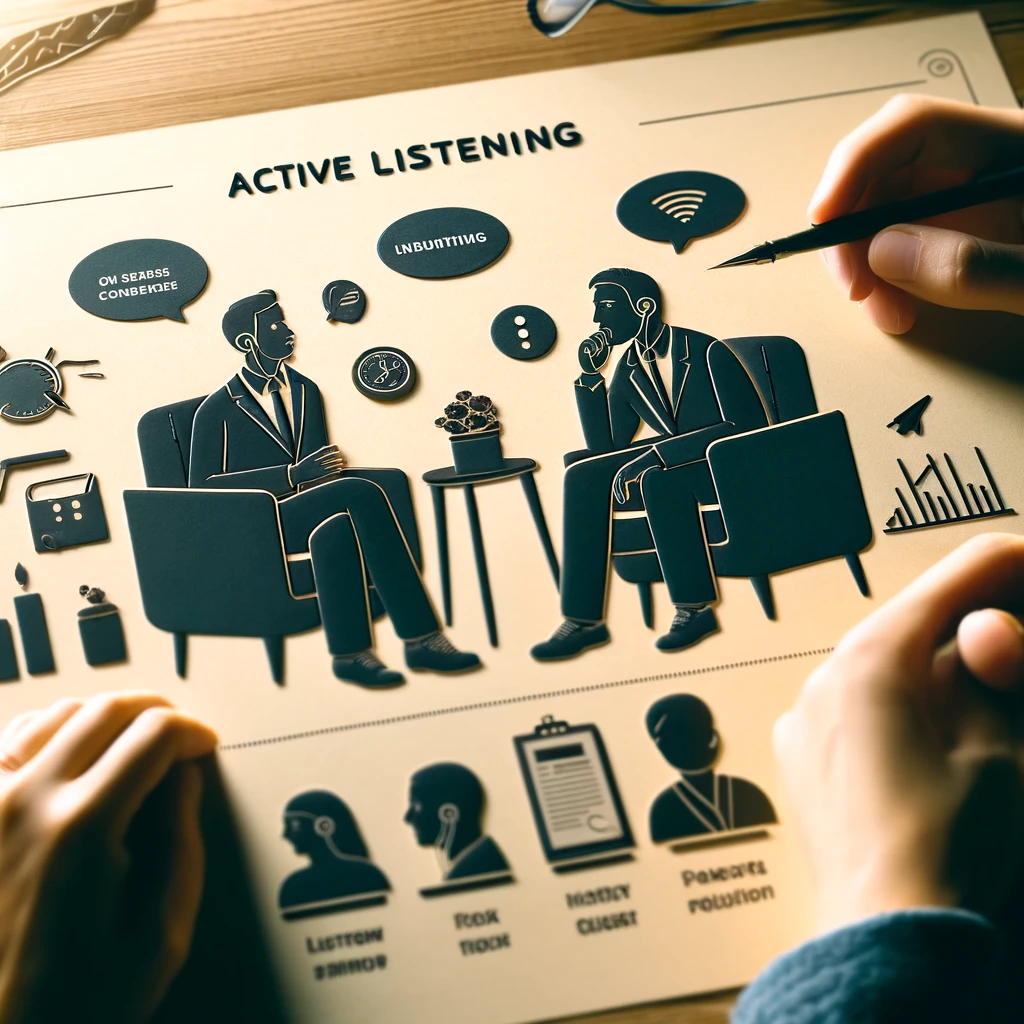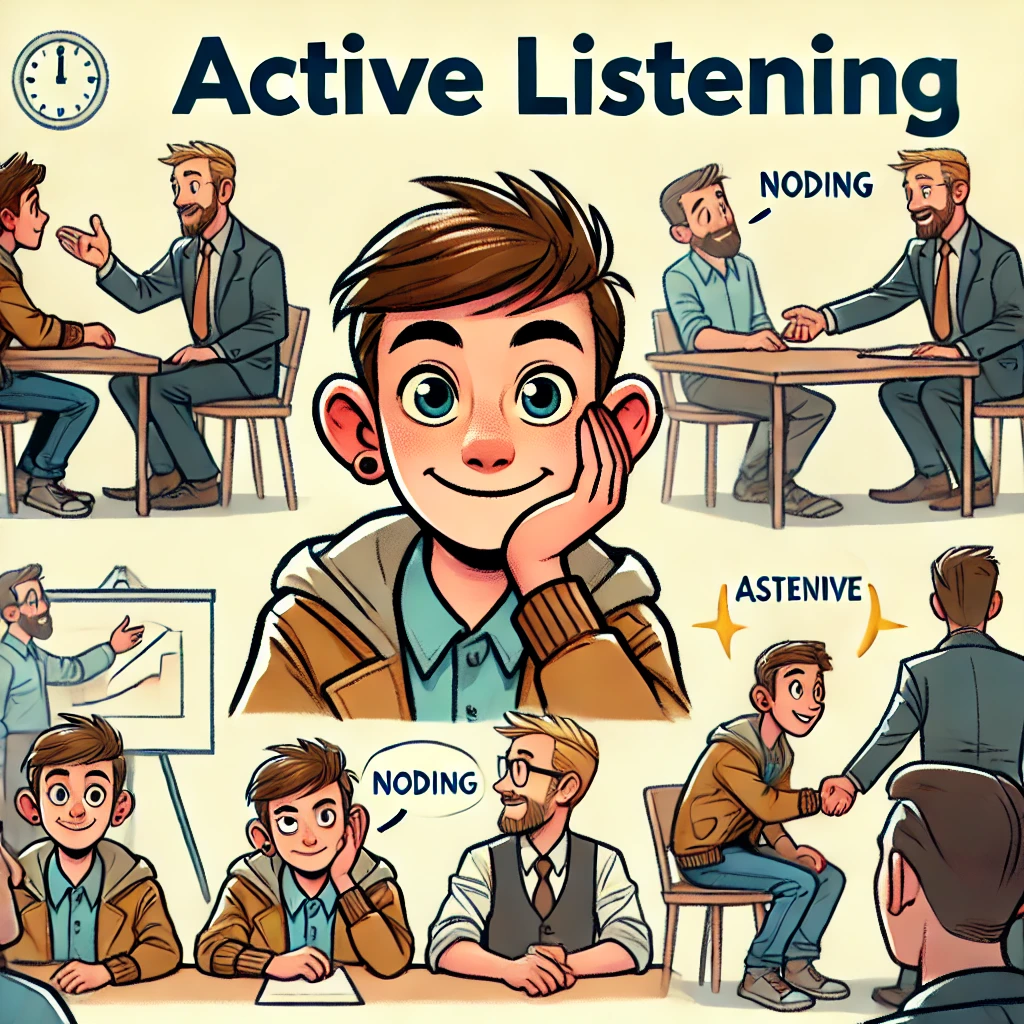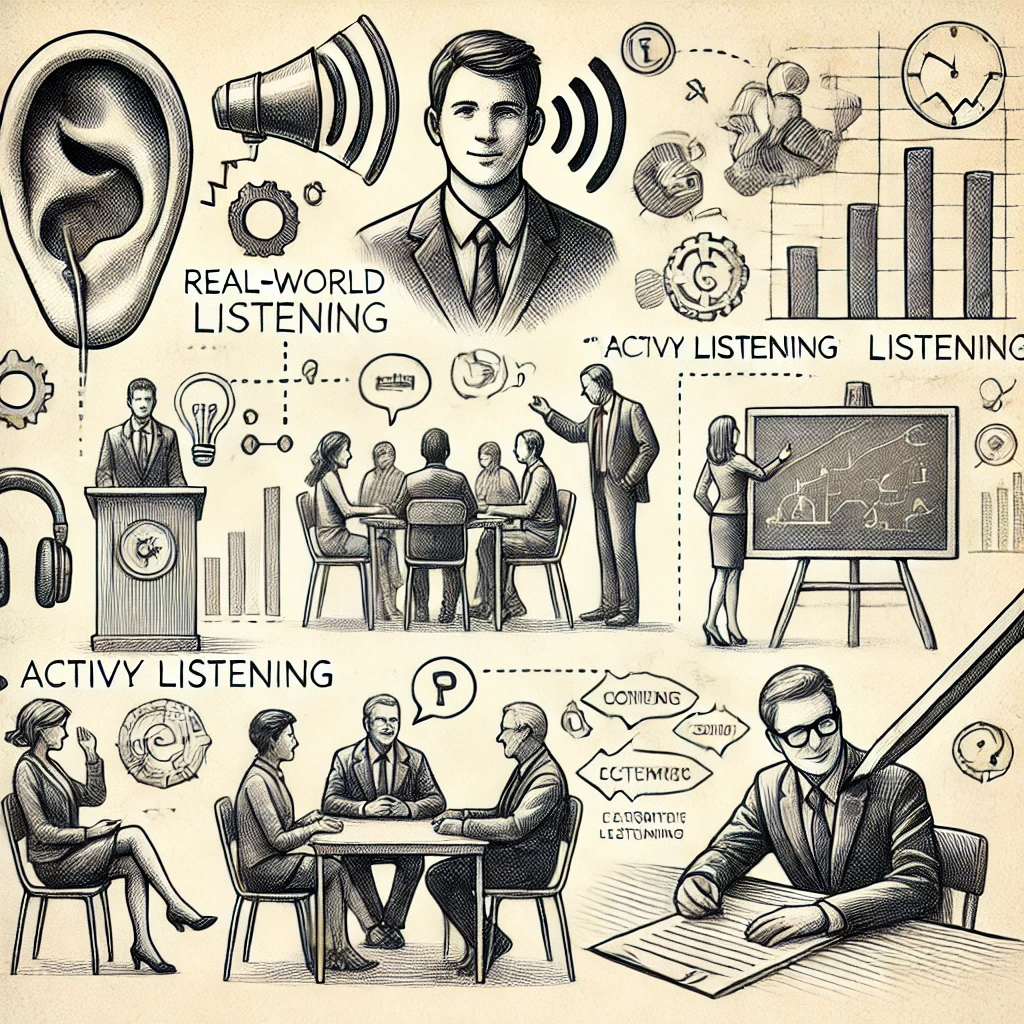Concept of Active Listening and Its Components

Active listening is a communication technique that involves giving full attention to the speaker, understanding their message, responding thoughtfully, and remembering what was said. It is a crucial skill in both personal and professional settings, as it enhances mutual understanding and builds stronger relationships.
Learning goals
- Understand the principles of active listening and its importance in communication.
- Develop skills to listen attentively and understand context in oral quizzes and conversations.
- Apply active listening strategies in real-world scenarios.
Components of Active Listening
Paying Attention
- Definition: Paying attention means being fully present in the conversation and focusing on the speaker without distractions. It involves using body language, facial expressions, and verbal cues to show that you are engaged.
- Examples:
- Body Language: Leaning slightly forward, maintaining eye contact, nodding occasionally.
- Facial Expressions: Smiling, frowning, or showing other expressions that reflect understanding and empathy.
- Verbal Cues: Saying “I see,” “Uh-huh,” “Right,” to indicate you are following along.
- Importance: Demonstrates respect for the speaker and ensures you do not miss important information.
Showing Understanding
- Definition: Showing understanding involves acknowledging the speaker’s message and reflecting it back to them. This can be done through paraphrasing or summarizing what has been said.
- Examples:
- Using verbal affirmations like “I see,” “I understand,” or “That makes sense.”
- Paraphrasing the speaker’s points to confirm understanding, e.g., “So, what you’re saying is…”
- Summarizing key points periodically to ensure clarity.
- Importance: Validates the speaker’s feelings and thoughts, showing that their message is being accurately received.
Providing Feedback
- Definition: Providing feedback is giving thoughtful and relevant responses that show you have processed the information shared. Feedback should be supportive and constructive, helping to advance the conversation.
- Examples:
- Asking open-ended questions to encourage further explanation, e.g., “Can you tell me more about that?”
- Reflecting on emotions expressed by the speaker, e.g., “It sounds like you’re really frustrated with this situation.”
- Giving constructive feedback if appropriate, e.g., “I think you handled that well, but have you considered trying this approach?”
- Importance: Keeps the conversation interactive and ensures that communication is a two-way process.

Active listening is more than just hearing words; it involves engaging with the speaker, understanding their message, and responding thoughtfully.
Learning activities
Group Discussion: Personal Listening Experiences (20 minutes)
Objective: Share your own experiences with listening and identify common challenges.
Instructions: The class will be divided into small groups. Each group will discuss times when they struggled to listen actively and how it affected the conversation. Share your insights with the whole class.

Listening and Paraphrasing Exercise (20 minutes)
Objective:
- Enhance Listening Skills: Develop your ability to listen attentively to spoken language.
- Improve Paraphrasing Skills: Strengthen your skills in accurately rephrasing and summarizing spoken information.
- Promote Clear Communication: Foster the ability to convey the essence of a message clearly and concisely in their own words.
- Build Confidence: Increase your confidence in your listening and speaking abilities through practice.
Instructions:
- Preparation (5 minutes):
- Form Pairs: You will be grouped in pairs. E
- Select or Prepare Material: You will be provided with short passages or stories to read. Alternatively, you can prepare your own short stories or personal anecdotes (about 3-4 sentences long).
- Activity Execution (15 minutes):
- Step 1: Reading and Listening:
- Student A Reads: One student (Student A) reads the short passage or tells a story aloud while the other student (Student B) listens attentively without taking notes.
- Active Listening: Student B should focus on understanding the main ideas and key details of the passage or story.
- Student B Paraphrases: After Student A finishes reading or telling the story, Student B paraphrases what they heard. The paraphrase should be in Student B’s own words, capturing the main ideas and essential details without repeating the text verbatim.
- Feedback: Student A provides feedback on the accuracy and completeness of the paraphrase, noting any important details that might have been missed or misunderstood.
- Debriefing (5 minutes):
- Group Discussion: After both rounds, the class will be brought together for a brief discussion. Share your experiences, focusing on what you found challenging and what strategies helped you paraphrase effectively.
- Key Points: It is important to capture the main ideas, use different words, and maintain the original meaning of the passage.
- Tips for Successful Paraphrasing:
- Listen for Key Ideas: Focus on the main points and essential details rather than trying to remember every word.
- Use Synonyms: Find alternative ways to express the same ideas using different words.
- Keep the Meaning: Ensure that the paraphrased version accurately reflects the original message without altering the intended meaning.
- Practice Active Listening: Pay close attention, avoid distractions, and mentally summarize what is being said as you listen.
- Role Reversal: Students switch roles, with Student B reading or telling a new passage or story and Student A listening and paraphrasing.
- Repeat Steps 1 and 2: The process is repeated, with the new listener now paraphrasing and the original listener providing feedback.

Real-World Listening Scenarios
Learning Objectives:
- Develop Active Listening Skills: Enhance your ability to listen attentively and understand spoken English in real-world contexts.
- Improve Comprehension: Strengthen your comprehension skills by interpreting and analyzing audio clips.
- Contextual Understanding: Learn to grasp the context and nuances of conversations, interviews, and news reports.
- Critical Thinking: Apply critical thinking to answer questions and discuss the content of the audio clips.
Instructions:
- Preparation (5 minutes):
- Introduction: Briefly explain the importance of active listening and how it can improve comprehension and communication skills.
- Audio Setup
- Listening Activity (20 minutes):
- Presentation of Audio Clips: You will hear various audio clips of conversations, interviews, or news reports.
- Individual Listening: Listen to each clip without interruption. Take notes on key points, contexts, and any unfamiliar vocabulary.
- Comprehension Questions and Discussion (5 minutes):
- Comprehension Questions: After each clip, you will be sked series of questions to check your understanding. With this we want to know which is the main idea, specific details, and contextual nuances.
- Here are some audions we will use: 10 Questions For Michael Chabon | TIME; Everyday English Conversation Practice;
- The BIGGEST Tech News You Probably Missed This Past Week

